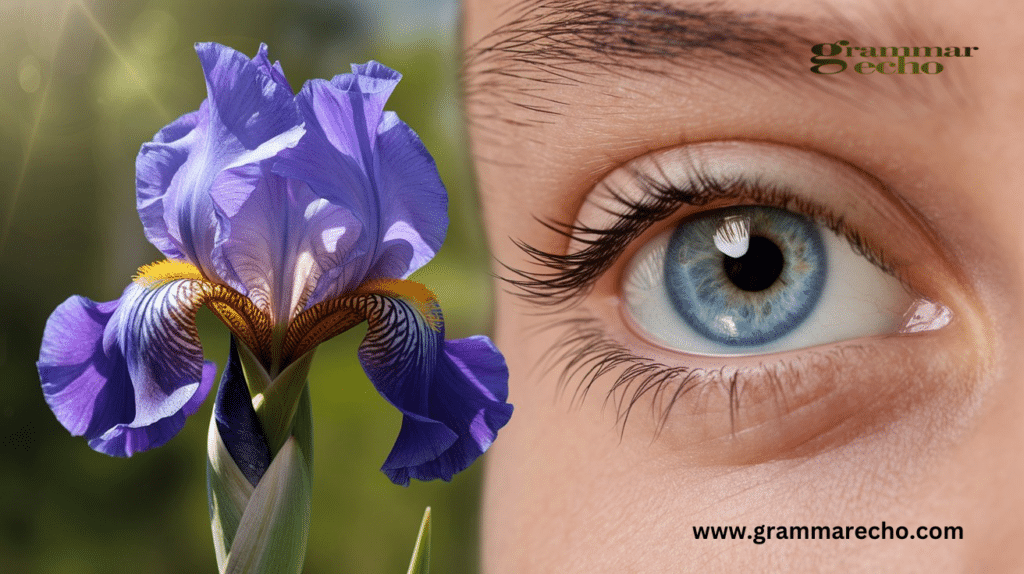Ever found yourself stumped by the plural of iris? You’re not alone. This seemingly simple word can tie even seasoned wordsmiths in knots. Whether you’re talking about those colorful flowers in your garden or the part of your eye that gives it its unique hue, knowing how to pluralize ‘iris’ correctly can be a real head-scratcher.
In this deep dive, we’ll unravel the mystery of ‘irises’ and ‘irides’, exploring their origins, usage, and the fascinating world they inhabit. From botanical gardens to the intricacies of eye anatomy, we’ll cover it all. So, let’s embark on this linguistic journey and clear up the confusion once and for all!
Must Read: Requester or Requestor: Which Spelling to Use?
The Dual Nature of Iris Plurals
When it comes to the plural of iris, we’re dealing with a word that’s got more layers than an onion. Believe it or not, there are two correct ways to pluralize ‘iris’: ‘irises’ and ‘irides’. Now, before you throw your hands up in despair, let’s break it down.
‘Irises’ is the more common plural form you’ll encounter in everyday speech. It’s what you’d use when talking about those stunning flowering plants that pop up in gardens come springtime. On the other hand, ‘irides’ is the plural form you might stumble upon in scientific papers or medical journals, especially when discussing eye anatomy.
But why the double trouble? Well, it all boils down to the word’s origins and how it’s been used over time. Let’s dig a little deeper, shall we?

Iris: A Word of Many Colors
Before we dive into the plural forms, let’s take a moment to appreciate the word ‘iris’ itself. It’s a term that’s as versatile as it is beautiful.
In botany, an iris is a genus of colorful flowers known for their distinctive shape and vibrant hues. These blooms have been captivating gardeners and artists for centuries. In fact, the famous painter Vincent van Gogh was so enamored with irises that he painted them multiple times during his stay at the asylum in Saint-Rémy-de-Provence.
But the iris isn’t just a pretty face in the plant world. In anatomy, it refers to the colored part of the eye that surrounds the pupil. The color of the iris is what we commonly refer to as eye color. It’s responsible for controlling the amount of light that enters the eye by adjusting the size of the pupil.
And here’s a fun fact for you: the word ‘iris’ comes from the Greek goddess Iris, who was the personification of the rainbow and served as a messenger between gods and humans. Talk about a colorful origin story!
You Must Read: Excell or Excel: What is the Correct Spelling?
The Common Plural: Irises
Now, let’s talk about ‘irises’, the plural form you’re most likely to encounter in everyday life. This is the go-to plural when you’re chatting about those beautiful blooms in your garden or the ones you spotted at the local botanical garden.
Here’s a scenario to help cement the usage:
Imagine you’re strolling through a flower market on a sunny Saturday morning. You overhear a conversation between a seasoned gardener and a novice:
Novice: “Wow, those purple flowers are stunning! What are they?”
Gardener: “Those are irises. Aren’t they gorgeous? Irises come in a wide range of colors, from deep purples to bright yellows and even white.”
Novice: “I’d love to plant some in my garden. Do all irises bloom at the same time?”
Gardener: “Not all irises bloom simultaneously. Some are early bloomers, while others flower later in the season. That’s why many gardeners plant different varieties of irises to enjoy a longer blooming period.”
In this context, using ‘irises’ as the plural form sounds natural and is easily understood. It’s the form you’d use in most non-scientific discussions about these flowering plants.

The Scientific Plural: Irides
Now, let’s switch gears and talk about ‘irides’, the plural form that might make you do a double-take if you’re not in the medical or scientific field. This form is primarily used when discussing the anatomy of the iris in a professional or academic context.
Here’s a scenario to illustrate its usage:
Picture a group of ophthalmology students gathered around their professor during a lecture on eye anatomy:
Professor: “Today, we’ll be discussing the various functions of the iris. Can anyone tell me what role the irides play in our vision?”
Student 1: “The irides control the amount of light entering our eyes by adjusting the size of the pupils.”
Professor: “Excellent. And how do the irides achieve this?”
Student 2: “The irides contain two types of muscles: the sphincter pupillae, which constrict the pupil, and the dilator pupillae, which dilate it.”
Professor: “Very good. Now, let’s examine how different irides can affect light sensitivity…”
In this scientific setting, using ‘irides’ as the plural form is more appropriate and aligns with the technical nature of the discussion.

You Must Read: Is Scrapped or Scraped? Let’s Clarify the Confusion
Singular Iris in Action
Before we delve deeper into the plurals, let’s take a moment to appreciate how the singular form ‘iris’ is used in various contexts. Understanding the singular usage can help us better grasp the nuances of its plural forms.
Botany: “The iris in my garden bloomed earlier than expected this year.”
Anatomy: “The doctor examined the patient’s iris for signs of inflammation.”
Photography: “Adjusting the camera’s iris can dramatically change the depth of field in your photos.”
Technology: “The iris scanner on my smartphone provides an extra layer of security.”
Literature: “The poet described her lover’s eyes, focusing on the flecks of gold in his iris.”
As you can see, the word ‘iris’ has a wide range of applications, from the natural world to cutting-edge technology. This versatility is part of what makes its pluralization so interesting.
Plurals in Practice: Irises vs. Irides
Now that we’ve covered the basics, let’s dive into how these plural forms are used in real-life situations. Understanding the context is key to choosing the right plural.
Blooming with Irises
When it comes to gardening and botany, ‘irises’ is the clear winner. Here’s how you might encounter it:
- In a gardening magazine: “Top 10 Irises for Your Spring Garden”
- At a flower show: “This year’s exhibition features over 50 varieties of irises from around the world.”
- In a conversation with a florist: “We have a beautiful selection of irises that would complement your bouquet perfectly.”
- In a botanical textbook: “Irises belong to the family Iridaceae and are known for their distinctive six-lobed flowers.”
Scientific Precision with Irides
In medical and scientific contexts, ‘irides’ takes center stage. Here’s where you might see it used:
- In an ophthalmology textbook: “The irides of different species show remarkable variation in structure and function.”
- During a medical conference presentation: “Our research focuses on the genetic factors influencing the pigmentation of human irides.”
- In a scientific paper abstract: “This study examines the response of feline irides to various light stimuli.”
- In a medical diagnosis: “The patient’s irides showed signs of heterochromia, a condition where the eyes have different colors.”
To further illustrate the difference, let’s look at a comparison table:
| Context | ‘Irises’ Usage | ‘Irides’ Usage |
| Gardening | “The irises in the botanical garden were in full bloom.” | Rarely used |
| Floristry | “We offer a variety of irises for wedding bouquets.” | Not used |
| General conversation | “I love how irises look in spring arrangements.” | Not used |
| Medical textbooks | Rarely used | “The structure of mammalian irides is highly complex.” |
| Scientific research | Not used | “Our study on avian irides revealed interesting patterns.” |
| Ophthalmology | Not used | “Examining patients’ irides can provide valuable diagnostic information.” |
You should never ignore to read: Cacoon or Cocoon: Which Spelling is Correct?
The Linguistic Journey of ‘Iris’
The story of ‘iris’ and its plurals is a fascinating journey through the annals of linguistic history. To truly appreciate the complexity of this word, we need to trace its roots back to ancient times.
The word ‘iris’ has its origin in words from both Latin and Greek. In Greek mythology, Iris was the goddess of the rainbow, serving as a messenger between the gods and humanity. The ancient Greeks used the word ‘iris’ (ἶρις) to refer to both the rainbow and the colorful part of the eye.
The Romans borrowed this word, keeping its form as ‘iris’ in Latin. As Latin evolved into the Romance languages and influenced English, ‘iris’ made its way into our vocabulary, retaining much of its original meaning and pronunciation.
Now, here’s where it gets interesting. In classical Latin, the plural of ‘iris’ was ‘irides’. This form followed the standard Latin pluralization rules for third-declension nouns ending in ‘-is’. However, as English developed its own rules for forming plurals, it became common to simply add ‘-es’ to words ending in ‘-is’, giving us ‘irises’.
This dual heritage is why we have two accepted plural forms today. ‘Irides’ represents the classical, Latinate plural, while ‘irises’ follows the more common English pluralization pattern.
Common Misconceptions and Errors
With two correct plural forms, it’s no wonder that people often get confused when it comes to pluralizing ‘iris’. Let’s address some common misconceptions and errors:
- “Iris’s” is not a correct plural form. This is a possessive form, not a plural. Incorrect: “I planted some new iris’s in my garden.” Correct: “I planted some new irises in my garden.”
- “Iri” is not a valid plural form. This might seem logical based on words like ‘cacti’, but it’s not correct for ‘iris’. Incorrect: “The iri in her eyes were a striking shade of green.” Correct: “The irides in her eyes were a striking shade of green.”
- Using ‘irises’ in scientific contexts isn’t technically wrong, but it may be frowned upon. Less preferred: “The study examined the irises of various bird species.” Preferred: “The study examined the irides of various bird species.”
- Similarly, using ‘irides’ when talking about garden flowers might sound overly formal or pretentious. Overly formal: “The irides in my garden are blooming beautifully this year.” Natural: “The irises in my garden are blooming beautifully this year.”
Remember, usage context is key. When in doubt, ‘irises’ is generally safe for everyday use, while ‘irides’ is best reserved for scientific or medical discussions.
Related Video:
Beyond Grammar: The Cultural Impact of Iris
The iris, in all its forms, has left an indelible mark on human culture, art, and science. Let’s explore some of these fascinating impacts:
- In Art: The iris has been a popular subject in painting for centuries. Claude Monet’s series of iris paintings are among his most celebrated works.
- In Literature: The iris often symbolizes hope, wisdom, and valor. In Tennessee Williams’ play “The Glass Menagerie,” the character of Blue Roses (whose real name is Laura) is associated with the blue iris, symbolizing her uniqueness and fragility.
- In Heraldry: The fleur-de-lis, which is stylized iris, has been used in coats of arms for centuries, most famously by the French monarchy.
- In Technology: Iris recognition is becoming an increasingly popular form of biometric identification, used in everything from smartphone unlocking to border control systems.
- In Medicine: The study of irides has led to advancements in understanding genetic disorders and has even been used in alternative medicine practices like iridology.
- In Horticulture: The cultivation of irises has become a passion for many, with iris societies and competitions held worldwide.
This cultural significance underscores why it’s so important to use the correct plural form in the right context. Whether you’re discussing a painting of irises or the genetic diversity of human irides, using the appropriate term shows respect for the subject matter and demonstrates linguistic precision.

Read Also: Totalling or Totaling (Which Spelling to Use?)
Practical Applications: When to Choose Which Plural
Now that we’ve explored the history and usage of both plural forms, let’s get practical. How do you know which form to use in your day-to-day life? Here are some guidelines:
- General Conversation: Stick with ‘irises’. It’s more widely recognized and won’t raise eyebrows in casual settings. Example: “The irises in the park are beautiful this time of year.”
- Gardening and Horticulture: Again, ‘irises’ is your go-to. Example: “I’m thinking of planting some bearded irises in my front yard.”
- Art and Literature: Unless you’re specifically referencing scientific works, ‘irises’ is the way to go. Example: “Van Gogh’s paintings of irises are among his most famous works.”
- Scientific and Medical Contexts: This is where ‘irides’ shines. Use it when discussing eye anatomy or in academic papers. Example: “The study examined the irides of patients with heterochromia.”
- Technical Writing: If you’re writing about iris recognition technology, you might use both forms depending on the specific context. Example: “While the system scans the irises of users, it’s the unique patterns in the irides that allow for accurate identification.”
Remember, the key is to consider your audience and the formality of the situation. When in doubt, ‘irises’ is generally the safer choice for non-scientific contexts.

The Future of ‘Iris’ in Language
As language evolves, so too does the usage of words like ‘iris’ and its plurals. Here are some trends and predictions for the future:
- Technological Influence: With the rise of iris recognition technology, we might see ‘iris’ and ‘irises’ becoming more common in everyday tech vocabulary.
- Scientific Dominance: In scientific fields, ‘irides’ is likely to remain the preferred plural form, reinforcing the divide between scientific and common usage.
- Artistic Renaissance: As digital art and photography continue to advance, we might see a resurgence of interest in irises as subjects, potentially bringing the word more into the public consciousness.
- Linguistic Simplification: There’s a general trend in English towards simplifying irregular plurals. While ‘irides’ is likely to persist in scientific contexts, we might see ‘irises’ becoming even more dominant in general usage.
- Global English: As English continues to be adopted as a global language, we might see regional variations in the usage of ‘irises’ and ‘irides’, influenced by local linguistic patterns.
Wrapping Up: Embracing the Duality of Iris Plurals
As we’ve seen, the plural of iris is more than just a grammatical quirk—it’s a window into the rich tapestry of the English language. From the colorful flowers in our gardens to the intricate anatomy of the iris in our eyes, this word bridges the gap between everyday life and scientific precision.
Remember:
- ‘Irises’ is your go-to plural for most situations, especially when talking about those beautiful flowering plants in your garden or the local botanical garden.
- ‘Irides’ is the choice for scientific and medical contexts, particularly when discussing eye anatomy.
The dual nature of iris plurals reflects the dynamic nature of language itself. It shows how words can evolve while still maintaining connections to their Latin and Greek roots. It’s a testament to the flexibility of English pluralization and the importance of usage context.
So the next time you’re admiring a bunch of purple irises or reading about the fascinating world of eye color, take a moment to appreciate the linguistic journey behind these terms. Whether you’re using ‘irises’ or ‘irides’, you’re participating in a rich tradition of language that spans centuries and disciplines.
In the end, language is about communication. By understanding and using these plural forms correctly, you’re not just showing off your grammar skills—you’re ensuring clear, precise communication, whether you’re in a garden, an art gallery, or a scientific laboratory. And isn’t that what language is all about?

Cora Lee is a dedicated grammarian and seasoned blogger at GrammarEcho.com, where she unravels the complexities of plural forms in English. With her engaging writing style, she helps readers master tricky plurals like “criteria,” “phenomena,” and “cacti.” Her passion for language clarity shines through her articles.








